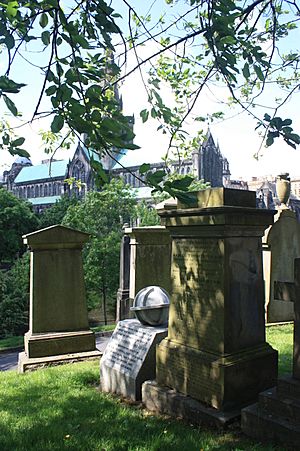James Thomson (mathematician) facts for kids
Quick facts for kids
James Thomson
|
|
|---|---|
 |
|
| Born | 13 November 1786 |
| Died | 12 January 1849 (aged 62) |
| Alma mater | University of Glasgow |
| Children | James Thomson The 1st Baron Kelvin |

James Thomson (born November 13, 1786, died January 12, 1849) was an Irish mathematician. He was very important in starting the study of thermodynamics at the University of Glasgow. He was also the father of two famous scientists: James Thomson, an engineer and physicist, and Lord Kelvin, a well-known physicist.
Contents
Early Life and Education
James Thomson was born on November 13, 1786. His family were Ulster-Scots farmers. He was the fourth son of Agnes Nesbit and James Thomson. They lived in a place called Annaghmore, near Ballynahinch in County Down, Ulster.
His father taught him at home when he was young. By the age of 11 or 12, James had already taught himself how to make a sundial. This shows he was very good at math from a young age. Later, he went to a school in Ballykine, run by Samuel Edgar. James soon became an assistant teacher there.
Becoming a Professor
James wanted to become a minister in the Presbyterian church. So, in 1810, he started studying at the University of Glasgow. He paid for his studies by teaching at the Ballykine school during the summer. He earned his Master of Arts (MA) degree in 1812.
In 1814, James got a job as the headmaster of a school in Belfast. This school taught arithmetic, bookkeeping, and geography. It was part of the new Academical Institution. The next year, in 1815, he became a professor of mathematics in the college part of the institution. He was known as a great teacher there.
In 1829, the University of Glasgow gave him an honorary degree called LLD. Then, in 1832, he became a professor of mathematics at the University of Glasgow itself. He stayed in this important job until he passed away on January 12, 1849.
Final Resting Place
James Thomson is buried with his family in the Glasgow Necropolis. This is a large cemetery in Glasgow. His grave is on the northern side, east of the main bridge. There is also a modern memorial nearby for his famous son, Lord Kelvin.
Published Works
James Thomson wrote many schoolbooks that were very popular. They were printed many times over the years. Here are some of his well-known books:
- ‘Arithmetic,’ first published in Belfast in 1819. It had 72 editions by 1880.
- ‘Trigonometry, Plane and Spherical,’ published in Belfast in 1820.
- ‘Introduction to Modern Geography,’ published in Belfast in 1827.
- ‘The Phenomena of the Heavens,’ also published in Belfast in 1827.
- ‘The Differential and Integral Calculus,’ published in 1831.
- ‘Euclid,’ published in 1834. This book was about geometry.
- ‘Atlas of Modern Geography.’
- ‘Algebra,’ published in 1844.
He also wrote a paper called ‘Recollections of the Battle of Ballynahinch, by an Eye-witness.’ This article appeared in the Belfast Magazine in February 1825.
Artistic Recognition
A famous artist named John Graham Gilbert RSA painted a portrait of James Thomson.
His Family
In 1817, James Thomson married Margaret Gardiner. She was the oldest daughter of William Gardiner from Glasgow. James and Margaret had seven children together, four sons and three daughters.
Two of their sons became very famous scientists:
- James Thomson (1822–1892), who was an engineer and physicist.
- William Thomson (1824–1907), who later became known as Lord Kelvin. He was one of the most important physicists of his time.


